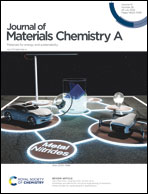Non-crystal-RuOx/crystalline-ZnO composites: controllable synthesis and high-performance toxic gas sensors†
Abstract
The construction of sensitive and durable sensitizers facilitates the development of metal oxide semiconductor (MOS)-based sensors with excellent gas sensing performance. Here, amorphous ruthenium oxide (RuOx) doped with lithium ions was successfully synthesized, and employed as a sensitizer to enhance the gas response of ZnO sensing materials. The gas sensing test results show that amorphous RuOx has better sensitization effects on ZnO than crystalline RuO2 at an optimum working temperature of 210 °C, such as a higher response, lower working temperature, better selectivity and faster response/recovery speed. The response of the RuOx/ZnO-1 sensor remains almost unchanged over a period of 60 days, while the RuOx sensitizer loaded on ZnO retains an amorphous structure after 60 days of working. Ex situ XPS also demonstrates that amorphous RuOx does not crystallize into polycrystalline RuO2 at 210 °C. The enhanced gas-sensing performance of the RuOx/ZnO-1 sensor can be attributed to the abundant active sites and better catalytic performance of amorphous RuOx, as well as enhanced electronic transmission between RuOx and ZnO. This is the first report showing that amorphous RuOx can work stably as a sensitizer at high temperature (210 °C), which facilitates the widespread use of amorphous metal catalysts in various fields.



 Please wait while we load your content...
Please wait while we load your content...